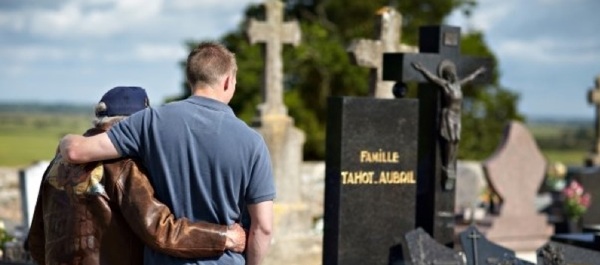
A World War II veteran in the twilight of his life stands once again on the soil where he fought the Nazis or the Imperial Japanese when he was young man. He remembers those long-gone days of terror and valor and thinks of friends who died before his eyes. In a voice tinged with age and emotion, he talks about what he saw and heard and felt. Why would he want to revisit the places where he saw hell erupt around him?
For many veterans, the experience brings a sense of closure to memories that often have been locked away like an old uniform for decades. They find healing in places where once they witnessed the worst and the best humanity has to offer. Sadly, many old vets who would like to have this closure cannot afford to travel back to Normandy or Iwo Jima or elsewhere.
It’s very emotional to see little kids running up to a vet with a bubblegum wrapper and a pen, asking for his autograph.
The Greatest Generations Foundation (TGGF) was established to make it possible for these honored warriors to take the odyssey back to their old battlegrounds, to see the results of what they and their companions sacrificed for, and often to receive the grateful thanks of people who were born long after those sacrifices were made. Its mission has also expanded to include educational activities such as “Take Living History Back to School Day,” a center for international studies, scholarships and more.
Recently, HistoryNet interviewed the organization’s founder, Australian-born Timothy Davis, as he was preparing to depart for Belgium with a group of veterans and college students.
HistoryNet.com: The name of this organization is unusual. Why call it the Greatest Generations – plural rather than singular?
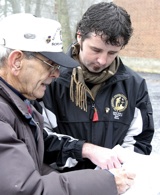 Timothy Davis: Being from Melbourne, Australia, you learn about the major conflicts in the 20th century through our educational system. I have always been inspired at the four major wars of the 20th century in which Australia and the US were involved. Australia has always been America’s strongest ally in these wars and continues to be today. Growing up, I heard Australian veterans telling their stories. In Australia, when we heard that Tom Brokaw expression, “the Greatest Generation,” we said, no, all those servicemen who fought in wars throughout the 20th century were apart of the greatest generation. Just like the generations of men and women that are serving in today’s military. So, I had that in back of my mind when I came to America.
Timothy Davis: Being from Melbourne, Australia, you learn about the major conflicts in the 20th century through our educational system. I have always been inspired at the four major wars of the 20th century in which Australia and the US were involved. Australia has always been America’s strongest ally in these wars and continues to be today. Growing up, I heard Australian veterans telling their stories. In Australia, when we heard that Tom Brokaw expression, “the Greatest Generation,” we said, no, all those servicemen who fought in wars throughout the 20th century were apart of the greatest generation. Just like the generations of men and women that are serving in today’s military. So, I had that in back of my mind when I came to America.
When we were forming the foundation, we brought in veterans from WWII, Korea and Vietnam wars to discuss this topic this in a round-table session, and the vets agreed: anyone who puts on a uniform to defend this great country are a part of the “greatest generation.”
HN: Tell us a bit about how this foundation got started back in 2004.
TD: I went to Europe for the 60th anniversary of D-Day, and I expected to see thousands of American World War II vets, maybe tens of thousands. Less than 400 Americans made the journey back to Normandy. I was flabbergasted. When I got home to Denver, I began to research World War II veterans.
“I asked them three questions: Would they go back if they could; would they like to go with family members or other veterans; and could they afford the trip?”
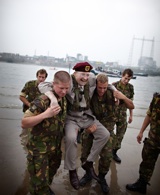 I discovered that most veterans would go back if they could, that they would prefer to go with other veterans, and that few could afford to do so on their own.
I discovered that most veterans would go back if they could, that they would prefer to go with other veterans, and that few could afford to do so on their own.
I came home, told my wife I’d some money saved up, and I wanted to use it to form a charity to finance veterans’ trips and to document their stories directly from the battlefield told in the words of those who were there. She said she’d stand by me whatever I decided.
HN: Which battle did you choose to center your first trip around?
TD: For the first trip, we got 15 veterans from across the country and took them to them back to the area of the Battle of Bulge – to commemorate the 60th Anniversary. I told them, “No strings, just tell us your stories on the battlefield.” They went home and started telling other vets about what the foundation had done for them, and veterans started sending in applications for trips. Nine-hundred-plus vets and many trips later, we continue to hear from veterans who want to be part of this program.
Our next event was in May 2005, the VE Day (Victory in Europe) anniversary. Over the course of the next three months, I located 30 of America’s finest veterans, men who had fought in Italy, North Africa, Normandy, Southern France, Holland, the Belgium and also veterans who served with the US Army Air Corps. Unfortunately, we couldn’t find any women veterans who had been there. We set out for a two-week journey from London to Southern Bavaria. Some of the participants had been involved in capturing the Eagles Nest (Hitler’s Bavarian enclave), liberated the Buchenwald death camps, while others were a part of the US cemetery grave commission, this was history at it’s finest.
On that trip, one veteran—Robert Bowen, author of Fighting with the Screaming Eagles: With the 101st Airborne from Normandy to Bastogne—wanted to visit Napoleon’s Tomb. As he was telling us how Napoleon’s Tomb was used as a temporary morgue during World War II, the clock at the tomb began its noon chimes. On the third chime, Mr. Bowen suddenly passed away from a massive heart attack. Our medics tried to help him but they couldn’t. The other 29 veterans said that what we had just experienced was the greatest gift we could give to someone in revisiting the site of great significance to him.
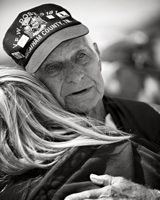 This really impacted me hard. When I returned home and decided I needed to do more with this. I went around the country talking to groups, associations on the urgency of this mission. At some point down the road I wanted to establish a scholarship fund in Mr. Bowen’s honor to let students and veterans travel together. The College of the Ozarks in southern Missouri contacted me in 2008 and asked to help coordinate the veterans/students program through our foundation.
This really impacted me hard. When I returned home and decided I needed to do more with this. I went around the country talking to groups, associations on the urgency of this mission. At some point down the road I wanted to establish a scholarship fund in Mr. Bowen’s honor to let students and veterans travel together. The College of the Ozarks in southern Missouri contacted me in 2008 and asked to help coordinate the veterans/students program through our foundation.
HN: How long has that program been going on now?
TD: We did our first of these tours in June of this year with 20 students, going to the D-Day beaches to commemorate the 65th Anniversary of Operation Overload. They were from 18 different states. All of them had a connection to Normandy campaign; a grandfather or some family member had fought there.
We weren’t sure how veterans would react to these students. When a vet opens up on a battlefield and tells his story, it can be very emotional. I stressed to the veterans that this was their opportunity to personally tell the next generation their stories. The next day, they were taking students by the hand, leading them around, telling them their stories.
As the veterans relive their history and share it with young Americans, this is healing for the veterans. According to many of the students who participated, these experiences change the way they view an older generation and World War II.
TD: On every trip, we are now taking students with us. This will provide the students with a direct link to experience living history first hand. I’m leaving later today for the Operation Market Garden tour, and we’re taking 12 students and 12 vets. We’ll do Pearl Harbor and the Battle of the Bulge in December, of course. Next year we have 16 trips scheduled. The first big one will be to Iwo Jima, with 15 students and 15 veterans.
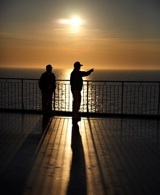 HN: Your grandfather was a World War II veteran. Where did he serve?
HN: Your grandfather was a World War II veteran. Where did he serve?
TD: He was in the Australian Navy in the South Pacific. During the island-hopping campaign, he was pretty much stationed in New Guinea and the Solomon Islands as a clean-up specialist attached to the US Navy. His job was cleaning up the debris and aftermath of each battle. Materiel recovered from beaches was shipped back to Australia to help continue the war effort.
His name is William Davis; he’s still living, but he has no interest in revisiting those South Pacific islands due to poor health. I regret that, but I respect it. He never really opened up to me about his experiences in the service till I was 16. I learned more about my family at a reunion in 1990. There was a scrapbook of our family’s military service. In the two World Wars, 11 members of our family served. None were in Korea or Vietnam, however.
HN: Why do you and The Greatest Generations Foundation regard aiding vets who want to revisit the battlefields where they once fought as important?
TD: I want to tell their stories. We feel that going back, seeing what they actually fought for, meeting the new generation of the people they liberated is closure for these veterans. At 80–90 years of life, it is very healing to find closure to something they put away for so long and never wanted to experience this again.
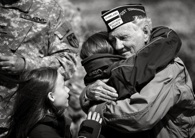 You know, people in other countries love Americans. Much of the negativity we hear is centered on Washington, Paris – it’s political. But once you get out of the major cities and meet the ordinary people who experienced war, those who enduring suffering, those who had family members wounded or killed, you find they love Americans. It’s very emotional to see little kids running up to a vet with a bubblegum wrapper and a pen, asking for his autograph.
You know, people in other countries love Americans. Much of the negativity we hear is centered on Washington, Paris – it’s political. But once you get out of the major cities and meet the ordinary people who experienced war, those who enduring suffering, those who had family members wounded or killed, you find they love Americans. It’s very emotional to see little kids running up to a vet with a bubblegum wrapper and a pen, asking for his autograph.
HN: Your traveling educational program “Take Living History Back to School Day” displays uniforms, weaponry, artifacts and photos from World War II. Do you intend to expand that to include other 20th century wars as well?
TD: We do. At this stage, we are focusing on World War II. When a vet comes back from a battlefield tour, we ask if he would like to participate in our living history school programs and taking children through these exhibits. This will help us to expand and continue our efforts to educate current and future generations about this important part of our history.
We plan to begin our Korea exhibit in 2011 and Vietnam in 2013, however, the biggest issue is getting volunteers to operate these programs in the communities.
HN: A teacher once told me his students didn’t know when major events had occurred, that they didn’t know which came first, World War II or the Vietnam War. When you go into schools, do you find students are “chronology challenged,” so to speak?
TD: Yes and no. It depends on where we go. Usually, we engage the teachers beforehand, so they’ve already completed orientation with the students on that war or battle we are focusing on. We’re looking at going into a community setting, meeting with teachers and civic leaders, and if they wish to participate we’ll provide them with orientation materials to help the students understand what our programs are about.
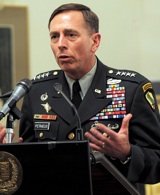 HN: The foundation also provides incentives for college students to get involved in their local history, doesn’t it?
HN: The foundation also provides incentives for college students to get involved in their local history, doesn’t it?
TD: That is correct. A lot of college students can’t come on our trips, for various reasons, so we encourage them to go to retirement facilities, associations retirement homes and elsewhere to collect veterans’ stories through the living history program. We usually have one vet with four students in a roundtable discussion.
That’s a pretty powerful program, when you see these students interacting with these veterans, it is pretty emotional. Often a vet doesn’t’ really want to talk about it, but he figures, “I’d better do it now before I pass.”
HN: Thanks for spending time with us. Is there anything you’d like to add?
TD: The World War I generation is all but gone; we have a good 5–10 years left to capture the stories of our World War II veterans. I urge them to contact Veterans Affairs or our foundation to find out how their stories can be preserved. Once we capture your story, we’ll be able to tell it, to continue the legacy you created.
I once told one of my vet friends, “Your story is a national treasure. If we allow it to go untold, shame on us, shame on us”
Click here to read what students who have traveled with The Greatest Generations Foundation’s tours say about their experiences.




